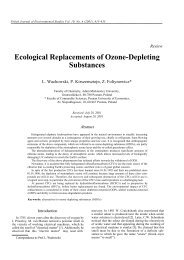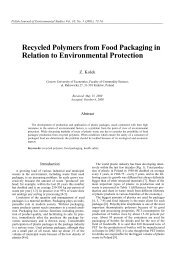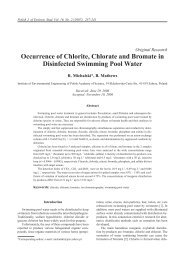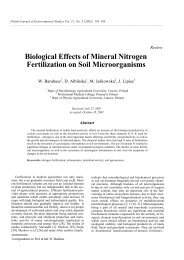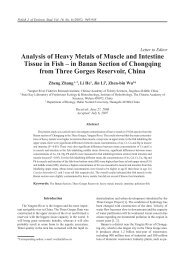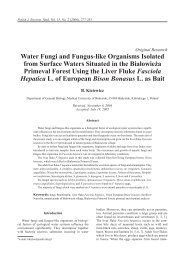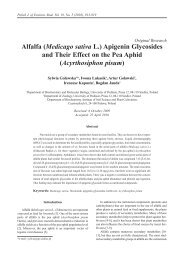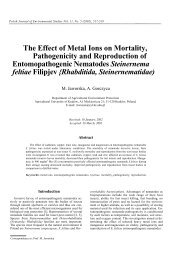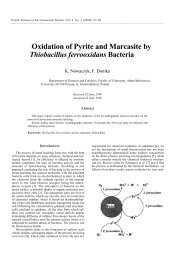Monitoring and Analytics of Atmospheric Air Pollution
Monitoring and Analytics of Atmospheric Air Pollution
Monitoring and Analytics of Atmospheric Air Pollution
You also want an ePaper? Increase the reach of your titles
YUMPU automatically turns print PDFs into web optimized ePapers that Google loves.
Polish Journal <strong>of</strong> Environmental Studies Vol. 11, No. 3 (2002), 211-218<br />
<strong>Monitoring</strong> <strong>and</strong> <strong>Analytics</strong> <strong>of</strong> <strong>Atmospheric</strong><br />
<strong>Air</strong> <strong>Pollution</strong><br />
Review<br />
J. Namieśnik, W. Wardencki<br />
Department <strong>of</strong> Analytical Chemistry, Chemical Faculty, Technical University <strong>of</strong> Gdansk,<br />
80-952 Gdansk-Wrzeszcz, 11/12 Narutowicza, Pol<strong>and</strong> Tel: (058) 347-<br />
10-10, Fax: (058) 347-26-94, e-mail:chemanal@pg.gda.pl<br />
Received: 10 September, 2001<br />
Accepted: 8 October, 2001<br />
Abstract<br />
This paper presents the tasks, procedures <strong>and</strong> instrumental trends in analytics <strong>and</strong> monitoring <strong>of</strong> air<br />
pollution. The classification <strong>of</strong> methods <strong>and</strong> analytical techniques used for atmospheric air studies are also<br />
discussed.<br />
Keywords: air pollution, monitoring, environmental analytics, monitors, sampling techniques<br />
Introduction<br />
The quality <strong>of</strong> atmospheric air, connected essentially<br />
with the level <strong>of</strong> pollutants due to transmission <strong>and</strong> deposition<br />
phenomena <strong>and</strong> secondary pollutant formation<br />
as a result <strong>of</strong> primary pollutant conversion, can affect the<br />
state <strong>of</strong> other environmental areas, mainly surface waters<br />
<strong>and</strong> soil.<br />
Therefore, it is necessary to obtain <strong>and</strong> collect versatile<br />
information on the type <strong>and</strong> quantity <strong>of</strong> pollutants<br />
that are present in air or are introduced to it from different<br />
emission sources.<br />
A great number <strong>of</strong> methods <strong>and</strong> analytical techniques<br />
are used to study atmospheric air. Generally, they can be<br />
classified according to the following parameters:<br />
- compound type (analyte) <strong>and</strong> its concentration level,<br />
- measurement mode (continuous or periodical),<br />
- period <strong>of</strong> investigation (long- or short-term measure<br />
ments),<br />
- automation level <strong>of</strong> measurements,<br />
- measurement sites (in situ, in laboratory),<br />
- manner <strong>of</strong> measuring (directly in sample or in second<br />
ary matrix),<br />
- sampling mode,<br />
- type <strong>of</strong> appliances used for sampling.<br />
On the basis <strong>of</strong> literature research, it can be concluded<br />
that analytics <strong>and</strong> monitoring <strong>of</strong> atmospheric air<br />
are those areas <strong>of</strong> environmental studies that are exp<strong>and</strong>ing<br />
most rapidly [1-8].<br />
Aims <strong>and</strong> Tasks <strong>of</strong> <strong>Atmospheric</strong> <strong>Air</strong><br />
<strong>Analytics</strong> <strong>and</strong> <strong>Monitoring</strong><br />
The use <strong>of</strong> appriopriate methods <strong>and</strong> analytical techniques<br />
in practise for air studies provides information<br />
necessary for: 1. assessment <strong>of</strong> pollutant emission,<br />
particularly:<br />
- identification <strong>of</strong> emission sources,<br />
- assessment <strong>of</strong> the interaction range <strong>of</strong> particular emit<br />
ters,<br />
Correspondence to: Pr<strong>of</strong>, dr hab. J. Namiesnik
212<br />
Namieśnik J., Wardencki W.<br />
Fig. 1. Classification <strong>of</strong> methods <strong>and</strong> devices used for sampling <strong>and</strong> analysis <strong>of</strong> gas samples.<br />
- estimation <strong>of</strong> technical effectiveness <strong>of</strong> protective<br />
measures,<br />
2. determination <strong>of</strong> ambient air pollutants <strong>and</strong> investiga<br />
tion <strong>of</strong> long-term trends in concentration changes,<br />
3. studies <strong>of</strong> processes in the atmosphere, i.e.:<br />
- transport <strong>and</strong> deposition <strong>of</strong> pollutants,<br />
- chemical, photochemical <strong>and</strong> biochemical conversion<br />
<strong>of</strong> pollutants,<br />
4. estimation <strong>of</strong> exposure rate <strong>and</strong> accumulation <strong>of</strong> pol<br />
lutants by living organisms.<br />
Such a wide spectrum <strong>of</strong> tasks for analysts dealing<br />
with air quality studies is possible due to the availability<br />
<strong>of</strong> various procedures <strong>and</strong> analytical techniques [9].<br />
Monitors - Specific Analytical<br />
Instruments<br />
Considering the analytical characteristics <strong>of</strong> instruments<br />
used in air studies two types <strong>of</strong> devices can be<br />
distinguished:<br />
- analysers, instruments used both for in situ measure<br />
ments (portable) <strong>and</strong> for the equipment <strong>of</strong> mobile ana<br />
lytical laboratories,<br />
- monitors, automatic devices belonging to this group<br />
should possess specific characteristics <strong>and</strong> fullfil sev<br />
eral methological <strong>and</strong> technical dem<strong>and</strong>s.<br />
The classification <strong>of</strong> devices used for sampling <strong>and</strong><br />
determination <strong>of</strong> analytes in atmospheric air is presented<br />
in Figure 1.<br />
Methodological dem<strong>and</strong>s:<br />
- high sensitivity <strong>of</strong> measurements,<br />
- providing analytical information in continuous mode in<br />
real time or with only a slight time delay,<br />
- high resolution <strong>of</strong> results ( characterised by short re<br />
sponse time),<br />
- long independent working time.<br />
Technical dem<strong>and</strong>s:<br />
- automatic instrument zeroing <strong>and</strong> calibration,<br />
- safe guarding system against sudden breaks in power<br />
supply,<br />
- equipment <strong>of</strong> instrument in<br />
(i) independent power supply<br />
(ii) calibration module<br />
(iii) system for filling <strong>and</strong> suplementing the working<br />
solution <strong>and</strong> reagents (electronic monitors)<br />
(iv) device protecting flame extinguishing (monitors<br />
based on FID <strong>and</strong> FPD)<br />
- possibility <strong>of</strong> automatic regeneration or exchange <strong>of</strong><br />
waste filters.<br />
Trends in <strong>Monitoring</strong> <strong>and</strong> <strong>Analytics</strong><br />
<strong>of</strong> <strong>Atmospheric</strong> <strong>Air</strong><br />
Vast information on new solutions appears each year<br />
in scientific literature that can be used in air studies.<br />
Examination <strong>of</strong> the available literature data enables us to<br />
distinguish a number <strong>of</strong> trends, both procedural <strong>and</strong> instrumental<br />
(caused mainly by new achievements in instrumentation)<br />
[10]. The most important trends include:
<strong>Monitoring</strong> <strong>and</strong> <strong>Analytics</strong> ...<br />
Procedural trends in environmental analytics <strong>and</strong> monitoring<br />
- widespread use <strong>of</strong> speciation analytics [11],<br />
- application <strong>of</strong> total (summarical) parameters to the<br />
evaluation <strong>of</strong> the pollution degree [12, 13],<br />
- search for determination <strong>of</strong> increasingly lower concen<br />
trations <strong>of</strong> analytes in samples with very complex ma<br />
trices [14, 15],<br />
- search for new methods for determining <strong>of</strong> many<br />
analytes using one sample <strong>and</strong> in one analytical cycle<br />
[16,17],<br />
- growing importance <strong>of</strong> bioanalytics <strong>and</strong> biomonitoring<br />
[18, 19],<br />
- the use <strong>of</strong> simple tests for initial evaluation <strong>of</strong> the pol<br />
lution degree <strong>of</strong> atmospheric air [20].<br />
Instrumental trends<br />
- new design <strong>of</strong> sensors <strong>and</strong> detectors [21, 22],<br />
- introduction <strong>of</strong> multidimensional techniques to prac<br />
tice, [23, 24],<br />
- automation, robotization <strong>and</strong> computerization <strong>of</strong><br />
measuring instruments [25, 26],<br />
- the use <strong>of</strong> expert systems [27, 28],<br />
- miniaturization <strong>of</strong> analytical instuments (introduction<br />
<strong>of</strong> electronic nose to analytical practice) [29],<br />
- design <strong>of</strong> passive devices for in situ measurements in<br />
cluding direct readings <strong>of</strong> analyte amount (concentra<br />
tion) [30, 31],<br />
213<br />
- development <strong>of</strong> remote sensing techniques for evalu<br />
ation <strong>of</strong> the pollution degree <strong>of</strong> the atmosphere [32],<br />
- the use <strong>of</strong> film techniques, photographical documenta<br />
tion <strong>and</strong> geographical information system (GIS) tech<br />
nology for evaluating air quality [3, 34].<br />
The trends that are particulary important for scientific<br />
research are discussed in more detail below.<br />
New Sampling Techniques for <strong>Atmospheric</strong><br />
Samples<br />
In analysis <strong>of</strong> air, due to low <strong>and</strong> frequently very low<br />
concentrations <strong>of</strong> analytes it is necessary to use special<br />
techniques combined with the simultaneous preconcentration<br />
<strong>of</strong> analytes. Generally, three sampling techniques<br />
are used [35]:<br />
- dynamic techniques,<br />
- passive techniques [36],<br />
- denudation techniques [37].<br />
The operating principles <strong>of</strong> particular sampling devices<br />
belonging to each group are schematically presented<br />
in Figure 2.<br />
A thorough examination <strong>of</strong> scientific literature leads<br />
to the conclusion that there is a vast procedural <strong>and</strong><br />
instrumental design connected with the above-mentioned<br />
sampling techniques. The designs described may<br />
be classified on the basis <strong>of</strong> parameters decisive on the<br />
Fig. 2. Schematic representation principle <strong>of</strong> operation <strong>of</strong> sampling devices using passive, dynamic <strong>and</strong> denuder techniques C - concentration<br />
<strong>of</strong> pollutant, Q - flow rate <strong>of</strong> sample, t - sampling time, d - tube diameter, L - height <strong>of</strong> stagnant air
214 Namieśnik J., Wardencki W.
<strong>Monitoring</strong> <strong>and</strong> <strong>Analytics</strong> ... 215
216 Namieśnik J., Wardencki W.<br />
destination <strong>and</strong> application range <strong>of</strong> the particular<br />
measurement set.<br />
The classifications <strong>of</strong> the sampling techniques mentioned<br />
above are presented in Figures 3-5.<br />
Application <strong>of</strong> Biological Methods in<br />
<strong>Analytics</strong> <strong>of</strong> <strong>Atmospheric</strong> <strong>Air</strong><br />
<strong>Pollution</strong>s<br />
Two terms are related with the application <strong>of</strong> biological<br />
methods for analytical purposes:<br />
- bioindicator, organism or communities <strong>of</strong> organisms<br />
that provide information on the state (quality) <strong>of</strong> the<br />
environment or the nature <strong>of</strong> environmental changes.<br />
The evaluation <strong>of</strong> threat degree is made on the basis <strong>of</strong><br />
visual analysis.<br />
- biomonitor, also organism or communities <strong>of</strong> organ<br />
isms that deliver information on the quantitative as<br />
pects <strong>of</strong> the quality <strong>of</strong> the environment or changes in<br />
environments. In this case, information is obtained<br />
from the results <strong>of</strong> measurements <strong>of</strong> properly chosen<br />
phytotests.<br />
Table 2. Techniques used for total hydrocarbon determination.
<strong>Monitoring</strong> <strong>and</strong> <strong>Analytics</strong> ...<br />
Organisms (or communities <strong>of</strong> organisms) can also be<br />
classified on the basis <strong>of</strong> their "mode <strong>of</strong> action" <strong>and</strong> their<br />
"origin". The characteristics <strong>of</strong> both types <strong>of</strong> indicators<br />
are given in Table 1.<br />
The application <strong>of</strong> bioindicators <strong>and</strong> biomonitors for<br />
evaluation <strong>of</strong> air pollution degree <strong>and</strong> its effects on the<br />
environment have presently become very popular. The<br />
criteria useful for selection <strong>of</strong> appropriate organisms as<br />
bioindicators for evaluating the pollution degree or pollutant<br />
influence on the environment were defined over<br />
twenty years ago [39] <strong>and</strong> are still actual:<br />
- relatively resident character <strong>of</strong> organisms (to fulfil rep<br />
resentative dem<strong>and</strong>s in relation to studied ecosystem),<br />
- wide distribution all over the examined area<br />
- facility to identify <strong>and</strong> to collect samples,<br />
- possibility <strong>of</strong> collecting an appropriate amount <strong>of</strong> ma<br />
terial for studies,<br />
- relatively good organism tolerance in relation to inves<br />
tigated pollutants (heavy metals, organic compounds,<br />
etc.),<br />
- facility to transplant <strong>of</strong> organisms to another place <strong>and</strong><br />
also to transport to laboratories,<br />
- population stability <strong>of</strong> chosen organism to assure<br />
multiple sampling in longer periods <strong>of</strong> time (to assess<br />
the trends),<br />
- existence <strong>of</strong> reasonable correlation between the degree<br />
<strong>of</strong> pollution <strong>of</strong> particular element <strong>of</strong> environment (air,<br />
water, sediments, food) <strong>and</strong> concentration <strong>of</strong> analyte in<br />
tissue (s) <strong>of</strong> selected organisms,<br />
- the same value <strong>of</strong> bioaccumulation factor <strong>of</strong> pollutants<br />
(biomagnification <strong>of</strong> analyte concentration in organism<br />
in relation to investigated environment) in different<br />
sites (this is not always possible because <strong>of</strong> different<br />
variables affecting the taking up <strong>of</strong> pollutants by<br />
a given organism).<br />
Application <strong>of</strong> Total (Summarical)<br />
Parameters to Studies <strong>of</strong><br />
<strong>Atmospheric</strong> <strong>Air</strong><br />
Considering the great variety <strong>of</strong> chemical compounds<br />
that can be atmospheric air pollutants, their separation<br />
<strong>and</strong> determination (speciation analysis) can be a very difficult<br />
<strong>and</strong> expensive task.<br />
The application <strong>of</strong> total parameters (giving total<br />
amount <strong>of</strong> a particular element - most frequently carbon<br />
- in all pollutants or a certain group <strong>of</strong> pollutants) en<br />
ables in many cases a limitation <strong>of</strong> the number <strong>of</strong> necess<br />
ary steps <strong>of</strong> analysis <strong>and</strong> faster evaluation <strong>of</strong> degree <strong>of</strong><br />
pollution.<br />
It should be noted that both approaches to pollution<br />
degree evaluation, i.e. tendency to measure all species<br />
(chemical forms) or their physical forms (speciation<br />
analysis) <strong>and</strong> determination <strong>of</strong> total parametrs are fully<br />
complementary [44].<br />
Two parameters are the most frequently used in analytics<br />
<strong>of</strong> air pollution: total hydrocarbons (TH) <strong>and</strong> total<br />
non-methane hydrocarbons (TNMTH). The contents <strong>of</strong><br />
these compounds are expressed as a sum calculated as<br />
carbon concentration (e.g. ppm <strong>of</strong> C).<br />
Short description <strong>of</strong> techniques used for measuring<br />
total hydrocarbons present in air samples is shown in<br />
Table 2.<br />
Concluding Remarks<br />
More detailed description <strong>of</strong> basic trends in monitoring<br />
<strong>of</strong> atmospheric air may be found in recently published<br />
reviews. It should be realized that such papers are to<br />
a large extent very subjective <strong>and</strong> depend both on degree<br />
<strong>of</strong> knowledge <strong>of</strong> literature data <strong>and</strong> personal experience.<br />
References<br />
217<br />
1. SOMMER L., VOZNICA P. Some aspects <strong>of</strong> contempor<br />
aneous analytical chemistry. A personal view. Chem. Papers.<br />
52, 184, 1999.<br />
2. NORSETH T. Measuring strategies for the Nineties. Future<br />
Needs from the Health Point <strong>of</strong> View. Analyst 119, 3, 1994.<br />
3. HIEFTJE G.M. But is it analytical chemistry? Am. Lab. 53,<br />
Oct.1993.<br />
4. SEVCIK J.G.K.Tasks <strong>and</strong> management <strong>of</strong> analytical chemis<br />
try at the beginning <strong>of</strong> the 21 s1 century. Chem. Listy. 90, 280,<br />
1996.<br />
5. TELLIARD W.A. Response to Comment on "Comment on<br />
an Alternative Minimum Level Definition for Analytical<br />
Quantification". Crit. Rev. Anal. Chem., 29, 249, 1999.<br />
6. MATHUR P.K., SUDERSANAN M. Recent developments<br />
<strong>of</strong> analytical instruments. Chem. Ind. Digest, Dec. 51, Dec.<br />
1998.<br />
7. JANATA J. The proper place <strong>of</strong> analytical chemistry in envi<br />
ronmental management. Crit. Rev. Anal. Chem., 29, 155,<br />
1999.<br />
8. BHARGAVA R.N. <strong>Atmospheric</strong> air pollution monitoring.<br />
Ind. J. Eng. Mat. Sci., 5, 249, 1998.<br />
9. NAMIESNIK J. Wykorzystanie analityki i monitoringu<br />
w badaniach srodowiska. Chem. Inz. Ekol. 5, 463,1998.<br />
10. NAMIESNIK J. Modern trends in monitoring <strong>and</strong> analysis<br />
<strong>of</strong> environmental pollutants. Pol. J. Environ. Stud. 10, 127,<br />
2001.<br />
11. KOT A., NAMIESNIK J. The role <strong>of</strong> speciation in analytical<br />
chemistry. Trends Anal. Chem. 19, 69, 2000.<br />
12. IWATSUKI M, KYOTANI T., MATSUBARA K. Frac<br />
tional determination <strong>of</strong> elemental carbon <strong>and</strong> total soluble<br />
<strong>and</strong> insoluble organic matter by thermal analysis combined<br />
with extraction <strong>and</strong> heavy liquid separation. Anal. Sci. 14,<br />
321, 1998.<br />
13. ROCHA T.A.P., OLIVEIRA J.A.B.P, DUARTE A.C. De<br />
termination <strong>of</strong> total sulphur in l<strong>and</strong>fill gases using quartz<br />
crystal microbalance. Inter. J. Environ. Anal. Chem. 75, 121,<br />
1999.<br />
14. NAMIESNIK J, WARDENCKI W. Solventless sample<br />
preparation techniques in environmental analysis. JHRC 23,<br />
297, 2000.<br />
15. LIMBECK A., PUXBAUM H. Organic acids in continental<br />
background aerosols. Inter. J. Environ. Anal. Chem. 73(4),<br />
329,1999.<br />
16. SCHUBERT P., ROSENBERG E., GRASSERBAUER M.<br />
Measurement <strong>of</strong> volatile organic compound (VOC) concen<br />
tration pr<strong>of</strong>iles in the atmosphere <strong>of</strong> a remote forest region.<br />
Inter. J. Environ. Anal. Chem. 75, 127, 1999.<br />
17. WANG J.L., DING W.H., CHEN T.Y. Source determina<br />
tion <strong>of</strong> light non-methane hydrocarbons by simultaneous<br />
multi-site sampling in na metropolitan area. Chemosphere,<br />
Global Change Sci. 2, 11, 2000.
218 Namieśnik J., Wardencki W.<br />
18. VISKARI E.L., KARENLAMPI L. Roadside Scots pine as<br />
an indicator <strong>of</strong> deicing salt use - a comparative study from<br />
two consecutive winters. Water, <strong>Air</strong>, Soil Pollut. 122, 405,<br />
2000.<br />
19. WAPPELHORST O., KORHAMMER S., LEFFLER U.S.,<br />
MARKERT B. Biomonitoring <strong>of</strong> mosses to evaluate the at<br />
mospheric inputs <strong>of</strong> elements in the region <strong>of</strong> the Neisse<br />
River. Z. Umweltchem, Okotox. 12, 191, 2000.<br />
20. MOOSBACH E., ROSENBOOM J., HARTKAMP H.<br />
Thin-layer detector tubes. A new system for the determina<br />
tion <strong>of</strong> trace gas in air by gas/solid-phase reactions followed<br />
by reemission photometric determination. Gefahrst<strong>of</strong>fe<br />
Reinh. Luft 59, 71, 1999.<br />
21. MEIJERINK M.G.H., STRITE D.J., DE ROOD N.F,<br />
KONDELKA-HEP M. Reproducible fabrication <strong>of</strong> an array<br />
<strong>of</strong> gas-sensitive chemo-resistors with polyaniline. Sensors<br />
Actuators. B68, 331, 2000.<br />
22. EKLOV T., LUNDSTROM I. Gas mixture analysis using<br />
a distributed chemical sensor system. Anal. Chem. 71, 3544,<br />
1999.<br />
23. MONDELLO L, CATALFAMO M, DUGO G., DUGO P.<br />
Multidimensional t<strong>and</strong>em capillary gas chromatography sys<br />
tem for the analysis <strong>of</strong> real complex samples. Part I: Devel<br />
opment <strong>of</strong> a fully automated t<strong>and</strong>em gas chromatography<br />
system. J. Chromatogr. Sci. 36, 201, 1998.<br />
24. DONARD O.F.X., MARTIN F.M. Hyphenated techniques<br />
applied to environmental speciation studies. Trends Anal.<br />
Chem. 11, 17, 1992.<br />
25. JAESCHKE W., SCHUNN H., HAUNOLD W. A continous<br />
flow instrument with flow regulation <strong>and</strong> automatic<br />
sensitivity range adaptation for the determination <strong>of</strong> atmos<br />
pheric H 2 S. Fresenius J. Anal. Chem. 351, 27, 1995.<br />
26. SOMMER L., VOZNICA P. Some aspects <strong>of</strong> the contem<br />
poraneous Analytical Chemistry. Chem. Papers 53 (3), 184,<br />
1999.<br />
27. VIARENGO A, BURLANDO B., GIORDANA A., BO-<br />
LOGNESI C, GABRIELIDES G.P. Networking <strong>and</strong> ex<br />
pert-sytem analysis: next frontier in biomonitoring. Mar. En<br />
viron. Res. 49, 483, 2000.<br />
28. PERIS M. An overview <strong>of</strong> recent expert system applications<br />
in analytical chemistry, Crit. Rev. Anal. Chem. 26, 219,<br />
1996.<br />
29. Me GILL R.A., NGUYEN V.K., CHUNG R., SHAFFER<br />
R.E., DILELLA D., STEPNOWSKI J.L. MLSNA T.E.,<br />
VENEZKY D.L., Dominguez D., The "NRL-SAW-<br />
RHINO": a nose for toxic gases. Sensors Actuators B65, 10,<br />
2000.<br />
30. MEUZELAAR H.L.C,B, DWORZANSKI J.P., ARNOLD<br />
N.S, MC CLEUNEN W.H., WAGER D.J. Advances in<br />
field-portable mobile GC/MS instrumenation, Field Anal.<br />
Chem. Technol. 4, 3, 2000.<br />
31. MATZ G., SCHRODER W., HARDER A., SCHILLINGS<br />
A., RECHENBACH P. Fast analysis <strong>of</strong> hazardous organics<br />
in fire <strong>and</strong> chemical accidents by mobile GC/MS. Field Anal.<br />
Chem. Technol. 1, 181, 1997.<br />
32. GONDAL M.A., MASTROMARINO J. Lidar system for<br />
remote environmental studies. Talanta 53, 147, 2000.<br />
33. ISHIDA H., YAMANAKA T, KUSHIDA N.,<br />
NAKAMOTO T, MORIIZUMI T. Study <strong>of</strong> real-time vis<br />
ualization <strong>of</strong> gas/odor flow image using gas sensor array.<br />
Sensors Actuators B65, 14, 2000.<br />
34. MAYNARD A., THOMPSON J., CAIN J.R., RAJAN B..<br />
<strong>Air</strong> movement visualization in the workplace: current<br />
methods <strong>and</strong> new approaches. Am. Ind. Hyg. Assoc. J. 61, 51<br />
2000.<br />
35. NAMIESNIK J. Techniques <strong>of</strong> enrichment <strong>of</strong> air trace pol<br />
lutants. Chem. Anal. 42, 487, 1997.<br />
36. NAMIESNIK J. Wykorzystanie dozymetrii pasywnej<br />
w analityce srodowiskowej. Chem. Inz. Ekol. 6, 1215, 1999.<br />
37. NAMIESNIK J., PILARCZYK M. A review <strong>of</strong> denudation<br />
technique <strong>of</strong> sampling <strong>and</strong> measurement <strong>of</strong> atmospheric<br />
trace constituents. Toxicol. Environ. Chem. 64, 203. 1997.<br />
38. MARKERT B, OEHLMAN J., ROTH M. General aspects<br />
<strong>of</strong> heavy metal monitoring by plants <strong>and</strong> animals. ASC<br />
Symp. Ser. 654, 18, 1997.<br />
39. LANGSTON W.J, SPENCE S.K. Biological factors in<br />
volved in metal concentration observed in aquatic organisms.<br />
In: Metal speciation <strong>and</strong> bioavailability in aquatic systems.<br />
(eds. A. Tessier, D.R. Turner) J. Wiley <strong>and</strong> Sons Ltd, 1995,<br />
chapter 9, p. 407.<br />
40. NAMIESNIK J, WARDENCKI W. Application <strong>of</strong> plants<br />
for monitoring <strong>of</strong> environmental pollution. Herba Polonica<br />
46, 198, 2000.<br />
41. NAMIESNIK J, WARDENCKI W. Wykorzystanie roslinnosci<br />
w biomonitoringu srodowiskowym, Chem. Inz. Ekol.<br />
7, 189, 2000.<br />
42. MARKERT B. , WAPPELHORST O, WECKERT V,<br />
HERPIN U, SIEVERS V, FRIESE H, BREULMAN G.<br />
The use <strong>of</strong> bioindicators for monitoring the heavy-metal<br />
status <strong>of</strong> the environment. J. Radioanal. Nucl. Chem. 240,<br />
425, 1999<br />
43. PAKEMAN R.J, HANKARD P.K, OSBORN D. Plants as<br />
biomonitors <strong>of</strong> atmospheric pollution: their potential <strong>of</strong> use<br />
in pollution regulation. Rev. Environ. Contain. Toxicol. 151,<br />
1, 1998.<br />
44. NAMIESNIK J. Przygotowanie probek srodowiskowych do<br />
analizy na zawartosc sktadnikow sladowych. Chem. Inz.<br />
Ekol. 7, 551, 2000.



